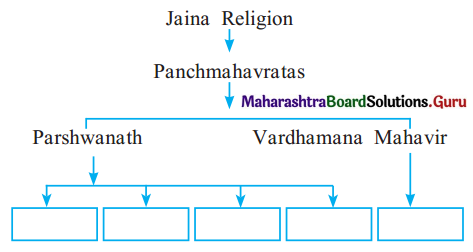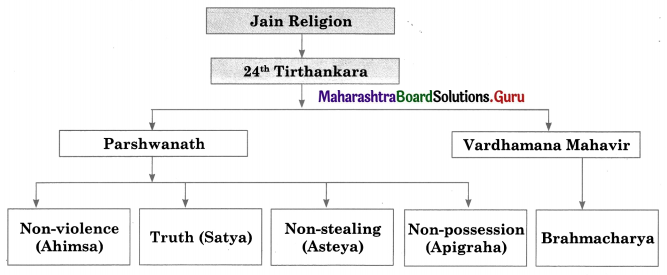Balbharti Maharashtra State Board Class 11 History Solutions
Chapter 6 Second Urbanisation in India Textbook Exercise Questions and Answers.
1A. Choose the correct alternative and write the complete sentences.
Question 1.
Ashmaka is the name in ____________ language.
(a) Pali
(b) Sanskrit
(c) Ardhamagadhi
(d) Prakrit
Answer:
(b) Sanskrit
Question 2.
The capital of Kashi Mahajanapadas was ____________
(a) Gorakhpur
(b) Chandranagar
(c) Raj agriha
(d) Varanasi
Answer:
(d) Varanasi

Question 3.
Gautam Buddha was born in ____________
(a) Kushinagara
(b) Sarnath
(c) Lumbini
(d) Pataliputra
Answer:
(c) Lumbini
Question 4.
The river ____________ was the natural boundary between Uttara Panchala and Dakshina Panchala.
(a) Yamuna
(b) Bhagirathi
(c) Ganga
(d) Niranjana
Answer:
(b) Bhagirathi
1B. Find the incorrect pair from set B and write the correct ones.
Question 1.
Answer:
(c) Matsya – Virat Nagar
2. Choose the correct reason and complete the sentence.
Question 1.
Gautam Buddha travelled continuously for 45 years ____________
(a) in search of a Guru
(b) to practice austerities
(c) to preach dhamma
(d) to attain enlightenment
Answer:
(c) to preach dhamma

3. Complete the concept maps.
Question 1.

Answer:

4. Explain the following statements with reasons.
Question 1.
The rise of Mahajanpadas came into being.
Answer:
Question 2.
The process of second urbanisation began in ancient India.
Answer:

Question 3.
Vardhamana Mahavira and Gautama Buddha attracted a large number of followers.
Answer:
5. Explain the following concepts.
Question 1.
Nastik Darshan
Answer:
Question 2.
The eightfold path was preached by Gautama Buddha.
Answer:
Gautama Buddha explained the eightfold path by including:
6. Describe the administrative system of the Mahajanapadas with the help of the following points.
Question 1.
(a) Terms showing types of states
(b) King’s installation
(c) Authority of the king
(d) Decision-making
Answer:
(a) Terms showing types of states: Rajya, Swarajya, Bhavjya, Vairajya, Maharajya, Samrajya, and Prameshthya were the different types of states that existed during the 6th B.C.E.
(b) King’s installation: A ‘Raja’ was expected to be a ‘Kshtriya’ and according to the existing norms, a Brahmin was expected to refrain from accepting the position of a Raja. The position of Raja was generally hereditary. However, at times, a king was elected by the people.
(c) Authority of the king: The coronation of a king gave him absolute authority over his subjects. He was the one to decide the amount of taxes to be collected from them. He was the ultimate lord of all the land in his kingdom and so he could donate any portion of that land according to his wish. Nevertheless, his power was not totally unrestricted.
(d) Decision-making: The king made his decisions by seeking advice from his officials such as Purohita, Senani, Amatya, Gramani, etc. Besides, there was an assembly of people of all classes. When it assembled everybody present could participate in the decision-making process. There were times when people’s assemblies made a king steps down from the throne.

Activity 1.
Collect and compile the information about Jain Tirthankaras.
Answer:
A “Tirthankara” is a saviour and spiritual teacher of the Jain dharma. Tirthankara in Sanskrit means ‘Ford-maker’ and is also known as “Jina” or “Victor”.
A Tirthankara is a rare individual who has conquered samsara, the cycle of death and rebirth
There were 24 Tirthankaras in Jainism. They are as follows:

Activity 2.
Collect information about Jataka stories. Select any of the Jataka stories and present, them as a stage play.
Answer:
Students have to do it on their own.
Chapter 6 Second Urbanisation in India Textbook Exercise Questions and Answers.
1A. Choose the correct alternative and write the complete sentences.
Question 1.
Ashmaka is the name in ____________ language.
(a) Pali
(b) Sanskrit
(c) Ardhamagadhi
(d) Prakrit
Answer:
(b) Sanskrit
Question 2.
The capital of Kashi Mahajanapadas was ____________
(a) Gorakhpur
(b) Chandranagar
(c) Raj agriha
(d) Varanasi
Answer:
(d) Varanasi

Question 3.
Gautam Buddha was born in ____________
(a) Kushinagara
(b) Sarnath
(c) Lumbini
(d) Pataliputra
Answer:
(c) Lumbini
Question 4.
The river ____________ was the natural boundary between Uttara Panchala and Dakshina Panchala.
(a) Yamuna
(b) Bhagirathi
(c) Ganga
(d) Niranjana
Answer:
(b) Bhagirathi
1B. Find the incorrect pair from set B and write the correct ones.
Question 1.
| Set ‘A’ | Set ‘B’ |
| (a) Kosala | Shravasti |
| (b) Anga | Champa |
| (c) Matsya | Mathura |
| (d) Gandhara | Taxila |
(c) Matsya – Virat Nagar
2. Choose the correct reason and complete the sentence.
Question 1.
Gautam Buddha travelled continuously for 45 years ____________
(a) in search of a Guru
(b) to practice austerities
(c) to preach dhamma
(d) to attain enlightenment
Answer:
(c) to preach dhamma

3. Complete the concept maps.
Question 1.

Answer:

4. Explain the following statements with reasons.
Question 1.
The rise of Mahajanpadas came into being.
Answer:
Question 2.
The process of second urbanisation began in ancient India.
Answer:

Question 3.
Vardhamana Mahavira and Gautama Buddha attracted a large number of followers.
Answer:
5. Explain the following concepts.
Question 1.
Nastik Darshan
Answer:
Question 2.
The eightfold path was preached by Gautama Buddha.
Answer:
Gautama Buddha explained the eightfold path by including:
6. Describe the administrative system of the Mahajanapadas with the help of the following points.
Question 1.
(a) Terms showing types of states
(b) King’s installation
(c) Authority of the king
(d) Decision-making
Answer:
(a) Terms showing types of states: Rajya, Swarajya, Bhavjya, Vairajya, Maharajya, Samrajya, and Prameshthya were the different types of states that existed during the 6th B.C.E.
(b) King’s installation: A ‘Raja’ was expected to be a ‘Kshtriya’ and according to the existing norms, a Brahmin was expected to refrain from accepting the position of a Raja. The position of Raja was generally hereditary. However, at times, a king was elected by the people.
(c) Authority of the king: The coronation of a king gave him absolute authority over his subjects. He was the one to decide the amount of taxes to be collected from them. He was the ultimate lord of all the land in his kingdom and so he could donate any portion of that land according to his wish. Nevertheless, his power was not totally unrestricted.
(d) Decision-making: The king made his decisions by seeking advice from his officials such as Purohita, Senani, Amatya, Gramani, etc. Besides, there was an assembly of people of all classes. When it assembled everybody present could participate in the decision-making process. There were times when people’s assemblies made a king steps down from the throne.

Activity 1.
Collect and compile the information about Jain Tirthankaras.
Answer:
A “Tirthankara” is a saviour and spiritual teacher of the Jain dharma. Tirthankara in Sanskrit means ‘Ford-maker’ and is also known as “Jina” or “Victor”.
A Tirthankara is a rare individual who has conquered samsara, the cycle of death and rebirth
There were 24 Tirthankaras in Jainism. They are as follows:

Activity 2.
Collect information about Jataka stories. Select any of the Jataka stories and present, them as a stage play.
Answer:
Students have to do it on their own.